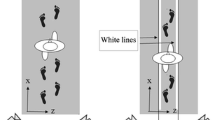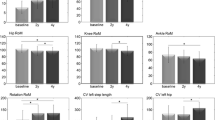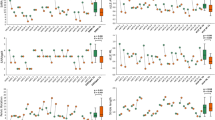Abstract
The aim of this study was to investigate the time-varying multi-muscle coactivation function (TMCf) in the lower limbs during gait and its relationship with the biomechanical and clinical features of patients with cerebellar ataxia. A total of 23 patients with degenerative cerebellar ataxia (16 with spinocerebellar ataxia, 7 with adult-onset ataxia of unknown etiology) and 23 age-, sex-, and speed-matched controls were investigated. The disease severity was assessed using the Scale for the Assessment and Rating of Ataxia (SARA) in all patients. During walking, simultaneous acquisition of kinematic, kinetic, and electromyography data was performed using a motion analysis system. The coactivation was processed throughout the gait cycle using the TMCf, and the following parameters were measured: synthetic coactivation index, full width at half maximum, and center of activity. Spatiotemporal (walking speed, stance duration, swing duration, first and second double-support durations, step length, step width, stride length, Center of Mass displacement), kinetic (vertical component of GRFs), and energy consumption (total energy consumption and mechanical energy recovered) parameters were also measured. The coactivation variables were compared between patients and controls and were correlated with both clinical and gait variables. A significantly increased global TMCf was found in patients compared with controls. In addition, the patients showed a significant shift of the center of activity toward the initial contact and a significant reduction in energy recovery. All coactivation parameters were negatively correlated with gait speed, whereas the coactivation index and center of activity were positively correlated with both center-of-mass mediolateral displacement values and SARA scores. Our findings suggest that patients use global coactivation as a compensatory mechanism during the earliest and most challenging subphase (loading response) of the gait cycle to reduce the lateral body sway, thus improving gait stability at the expense of effective energy recovery. This information could be helpful in optimizing rehabilitative treatment aimed at improving lower limb muscle control during gait in patients with cerebella ataxia.





Similar content being viewed by others
References
Earhart GM, Bastian AJ. Selection and coordination of human locomotor forms following cerebellar damage. J Neurophysiol [Internet]. American Physiological SocietyBethesda, MD; 2001 [cited 2019 Jul 11];85:759–69. Available from: https://doi.org/10.1152/jn.2001.85.2.759
Stolze H, Klebe S, Petersen G, Raethjen J, Wenzelburger R, Witt K, et al. Typical features of cerebellar ataxic gait. J Neurol Neurosurg Psychiatry [Internet]. BMJ Publishing Group Ltd; 2002 [cited 2019 Jul 11];73:310–2. Available from: http://www.ncbi.nlm.nih.gov/pubmed/12185166
Morton SM, Bastian AJ. Relative contributions of balance and voluntary leg-coordination deficits to cerebellar gait ataxia. J Neurophysiol [Internet]. American Physiological SocietyBethesda, MD; 2003 [cited 2019 Jul 11];89:1844–56. Available from: https://doi.org/10.1152/jn.00787.2002
Ilg W, Golla H, Thier P, Giese MA. Specific influences of cerebellar dysfunctions on gait. Brain [Internet]. Narnia; 2007 [cited 2019 Jul 11];130:786–98. Available from: https://doi.org/10.1093/brain/awl376
Ilg W, Branscheidt M, Butala A, Celnik P, de Paola L, Horak FB, et al. Consensus Paper: Neurophysiological assessments of ataxias in daily practice. The Cerebellum [Internet]. Springer US; 2018 [cited 2019 Jul 11];17:628–53. Available from: https://doi.org/10.1007/s12311-018-0937-2
Ilg W, Timmann D. Gait ataxia-specific cerebellar influences and their rehabilitation. Mov Disord [Internet]. John Wiley & Sons, Ltd; 2013 [cited 2019 Jul 11];28:1566–75. Available from: https://doi.org/10.1002/mds.25558
Serrao M, Pierelli F, Ranavolo A, Draicchio F, Conte C, Don R, et al. Gait pattern in inherited cerebellar ataxias. The Cerebellum [Internet]. Springer-Verlag; 2012 [cited 2019 Jul 11];11:194–211. Available from: https://doi.org/10.1007/s12311-011-0296-8
Serrao M. Rehabilitation of ataxias. Springer, Cham; 2018 [cited 2019 Jul 11]. p. 195–200. Available from: https://doi.org/10.1007/978-3-319-72736-3_13
Serrao M, Conte C. Detecting and measuring ataxia in gait. Handb Hum Motion [Internet]. Cham: Springer International Publishing; 2018 [cited 2019 Jul 11]. p. 937–54. Available from: https://doi.org/10.1007/978-3-319-14418-4_46
Serrao M, Ranavolo A, Casali C. Neurophysiology of gait. Handb Clin Neurol [Internet]. Elsevier; 2018 [cited 2019 Jul 11];154:299–303. Available from: https://www.sciencedirect.com/science/article/pii/B9780444639561000187
Serrao M, Chini G, Iosa M, Casali C, Morone G, Conte C, et al. Harmony as a convergence attractor that minimizes the energy expenditure and variability in physiological gait and the loss of harmony in cerebellar ataxia. Clin Biomech (Bristol, Avon) [Internet]. Elsevier; 2017 [cited 2019 Jul 11];48:15–23. Available from: http://www.ncbi.nlm.nih.gov/pubmed/28704694
Serrao M, Conte C, Casali C, Ranavolo A, Mari S, Di Fabio R, et al. Sudden stopping in patients with cerebellar ataxia. The Cerebellum [Internet]. Springer US; 2013 [cited 2019 Jul 11];12:607–16. Available from: https://doi.org/10.1007/s12311-013-0467-x
Serrao M, Mari S, Conte C, Ranavolo A, Casali C, Draicchio F, et al. Strategies Adopted by cerebellar ataxia patients to perform u-turns. The Cerebellum [Internet]. Springer US; 2013 [cited 2019 Jul 11];12:460–8. Available from: https://doi.org/10.1007/s12311-012-0441-z
Conte C, Serrao M, Casali C, Ranavolo A, Silvia M, Draicchio F, et al. Planned gait termination in cerebellar ataxias. The Cerebellum [Internet]. Springer-Verlag; 2012 [cited 2019 Jul 11];11:896–904. Available from: https://doi.org/10.1007/s12311-011-0348-0
Conte C, Pierelli F, Casali C, Ranavolo A, Draicchio F, Martino G, et al. Upper body kinematics in patients with cerebellar ataxia. The Cerebellum [Internet]. Springer US; 2014 [cited 2019 Jul 11];13:689–97. Available from: https://doi.org/10.1007/s12311-014-0586-z
Mari S, Serrao M, Casali C, Conte C, Martino G, Ranavolo A, et al. Lower limb antagonist muscle co-activation and its relationship with gait parameters in cerebellar ataxia. The Cerebellum [Internet]. Springer US; 2014 [cited 2019 Jul 11];13:226–36. Available from: https://doi.org/10.1007/s12311-013-0533-4
van de Warrenburg BPC, Steijns JAG, Munneke M, Kremer BPH, Bloem BR. Falls in degenerative cerebellar ataxias. Mov Disord [Internet]. John Wiley & Sons, Ltd; 2005 [cited 2019 Jul 11];20:497–500. Available from: https://doi.org/10.1002/mds.20375
Schniepp R, Wuehr M, Schlick C, Huth S, Pradhan C, Dieterich M, et al. Increased gait variability is associated with the history of falls in patients with cerebellar ataxia. J Neurol [Internet]. Springer Berlin Heidelberg; 2014 [cited 2019 Jul 11];261:213–23. Available from: https://doi.org/10.1007/s00415-013-7189-3
Schniepp R, Schlick C, Pradhan C, Dieterich M, Brandt T, Jahn K, et al. The interrelationship between disease severity, dynamic stability, and falls in cerebellar ataxia. J Neurol [Internet]. Springer Berlin Heidelberg; 2016 [cited 2019 Jul 11];263:1409–17. Available from: https://doi.org/10.1007/s00415-016-8142-z
Morton SM, Bastian AJ. Cerebellar control of balance and locomotion. Neurosci [Internet]. Sage PublicationsSage CA: Thousand Oaks, CA; 2004 [cited 2019 Jul 11];10:247–59. Available from: https://doi.org/10.1177/1073858404263517
Konczak J, Timmann D. The effect of damage to the cerebellum on sensorimotor and cognitive function in children and adolescents. Neurosci Biobehav Rev [Internet]. Pergamon; 2007 [cited 2019 Jul 11];31:1101–13. Available from: https://www.sciencedirect.com/science/article/pii/S0149763407000504
Bodranghien F, Bastian A, Casali C, Hallett M, Louis ED, Manto M, et al. Consensus paper: revisiting the symptoms and signs of cerebellar syndrome. The Cerebellum [Internet]. Springer US; 2016 [cited 2019 Jul 11];15:369–91. Available from: https://doi.org/10.1007/s12311-015-0687-3
Vasco G, Gazzellini S, Petrarca M, Lispi ML, Pisano A, Zazza M, et al. Functional and gait assessment in children and adolescents affected by Friedreich’s ataxia: A One-Year Longitudinal Study. Palau F, editor. PLoS One [Internet]. Public Library of Science; 2016 [cited 2019 Jul 11];11:e0162463. Available from: https://doi.org/10.1371/journal.pone.0162463
Caliandro P, Iacovelli C, Conte C, Simbolotti C, Rossini PM, Padua L, et al. Trunk-lower limb coordination pattern during gait in patients with ataxia. Gait Posture [Internet]. Elsevier; 2017 [cited 2019 Jul 11];57:252–7. Available from: https://www.sciencedirect.com/science/article/abs/pii/S0966636217304903?via%3Dihub
Martino G, Ivanenko YP, Serrao M, Ranavolo A, d’Avella A, Draicchio F, et al. Locomotor patterns in cerebellar ataxia. J Neurophysiol [Internet]. American Physiological Society Bethesda, MD; 2014 [cited 2019 Jul 11];112:2810–21. Available from: http://www.physiology.org/doi/10.1152/jn.00275.2014
Conte C, Serrao M, Cuius L, Ranavolo A, Conforto S, Pierelli F, et al. Effect of restraining the base of support on the other biomechanical features in patients with cerebellar ataxia. The Cerebellum [Internet]. Springer US; 2018 [cited 2019 Jul 11];17:264–75. Available from: https://doi.org/10.1007/s12311-017-0897-y
Martino G, Ivanenko YP, d’Avella A, Serrao M, Ranavolo A, Draicchio F, et al. Neuromuscular adjustments of gait associated with unstable conditions. J Neurophysiol [Internet]. American Physiological Society Bethesda, MD; 2015 [cited 2019 Jul 11];114:2867–82. Available from: http://www.physiology.org/doi/10.1152/jn.00029.2015
Ranavolo A, Mari S, Conte C, Serrao M, Silvetti A, Iavicoli S, et al. A new muscle co-activation index for biomechanical load evaluation in work activities. Ergonomics [Internet]. Taylor & Francis; 2015 [cited 2019 Jul 11];58:966–79. Available from: https://doi.org/10.1080/00140139.2014.991764
Varrecchia T, Rinaldi M, Serrao M, Draicchio F, Conte C, Conforto S, et al. Global lower limb muscle coactivation during walking at different speeds: Relationship between spatio-temporal, kinematic, kinetic, and energetic parameters. J Electromyogr Kinesiol [Internet]. Elsevier; 2018 [cited 2019 Jul 11];43:148–57. Available from: https://www.sciencedirect.com/science/article/pii/S1050641118301949?via%3Dihub
Ivanenko YP, Cappellini G, Solopova IA, Grishin AA, MacLellan MJ, Poppele RE, et al. Plasticity and modular control of locomotor patterns in neurological disorders with motor deficits. Front Comput Neurosci [Internet]. Frontiers; 2013 [cited 2019 Jul 11];7:123. Available from: https://doi.org/10.3389/fncom.2013.00123/abstract
Hamacher D, Hamacher D, Krowicki M, Schega L. Between-day test–retest reliability of gait variability in older individuals improves with a familiarization trial. Aging Clin Exp Res [Internet]. Springer International Publishing; 2017 [cited 2019 Jul 22];29:327–9. Available from: https://doi.org/10.1007/s40520-016-0536-3
Davis RB, Õunpuu S, Tyburski D, Gage JR. A gait analysis data collection and reduction technique. Hum Mov Sci [Internet]. North-Holland; 1991 [cited 2019 Jul 11];10:575–87. Available from: https://www.sciencedirect.com/science/article/abs/pii/016794579190046Z
Barbero M, Merletti R, Rainoldi A. Atlas of muscle innervation zones : understanding surface electromyography and its applications [Internet]. Springer; 2012 [cited 2019 Jul 11]. Available from: https://books.google.it/books?hl = it&lr = &id = rWF-8HE9kf8C&oi = fnd&pg = PR3&dq = Barbero+et + al.,+2012 + muscular+innervation+&ots = FCSkl1AV_L&sig = 1LRLtWiS36xz46zjTvcC-tkv2XM&redir_esc = y#v = onepage&q = Barbero et al.%2C 2012 muscular innervation&f = false
Ranaldi S, De Marchis C, Conforto S. An automatic, adaptive, information-based algorithm for the extraction of the sEMG envelope. J Electromyogr Kinesiol [Internet]. Elsevier; 2018 [cited 2019 Jul 11];42:1–9. Available from: https://www.sciencedirect.com/science/article/pii/S1050641118301445?via%3Dihub
Serrao M, Rinaldi M, Ranavolo A, Lacquaniti F, Martino G, Leonardi L, et al. Gait Patterns in patients with hereditary spastic paraparesis. Macaluso A, editor. PLoS One [Internet]. Public Library of Science; 2016 [cited 2019 Jul 11];11:e0164623. Available from: https://doi.org/10.1371/journal.pone.0164623
Le P, Best TM, Khan SN, Mendel E, Marras WS. A review of methods to assess coactivation in the spine. J Electromyogr Kinesiol [Internet]. Elsevier; 2017 [cited 2019 Jul 11];32:51–60. Available from: https://www.sciencedirect.com/science/article/pii/S1050641116300943
Rinaldi M, Ranavolo A, Conforto S, Martino G, Draicchio F, Conte C, et al. Increased lower limb muscle coactivation reduces gait performance and increases metabolic cost in patients with hereditary spastic paraparesis. Clin Biomech [Internet]. Elsevier; 2017 [cited 2019 Jul 11];48:63–72. Available from: https://www.sciencedirect.com/science/article/pii/S0268003317301663
Rinaldi M, D’Anna C, Schmid M, Conforto S. Assessing the influence of SNR and pre-processing filter bandwidth on the extraction of different muscle co-activation indexes from surface EMG data. J Electromyogr Kinesiol [Internet]. Elsevier; 2018 [cited 2019 Jul 23];43:184–92. Available from: https://www.sciencedirect.com/science/article/pii/S1050641118302384
Fisher NI. Statistical analysis of circular data [Internet]. Cambridge University Press; 1995 [cited 2019 Jul 11]. Available from: https://books.google.it/books?hl = it&lr = &id = wGPj3EoFdJwC&oi = fnd&pg = PA1&ots = Pk0pEwyDTa&sig = snP8a_Q1kRZ4Z-QAJnSLvuOsnYg&redir_esc = y#v = onepage&q&f = false
Kadaba MP, Ramakrishnan HK, Wootten ME, Gainey J, Gorton G, Cochran GVB. Repeatability of kinematic, kinetic, and electromyographic data in normal adult gait. J Orthop Res [Internet]. John Wiley & Sons, Ltd; 1989 [cited 2019 Jul 25];7:849–60. Available from: https://doi.org/10.1002/jor.1100070611
Steinwender G, Saraph V, Scheiber S, Zwick EB, Uitz C, Hackl K. Intrasubject repeatability of gait analysis data in normal and spastic children. Clin Biomech [Internet]. Elsevier; 2000 [cited 2019 Jul 11];15:134–9. Available from: https://www.sciencedirect.com/science/article/pii/S0268003399000571
Ranavolo A, Don R, Draicchio F, Bartolo M, Serrao M, Padua L, et al. Modelling the spine as a deformable body: Feasibility of reconstruction using an optoelectronic system. Appl Ergon [Internet]. Elsevier; 2013 [cited 2019 Jul 11];44:192–9. Available from: https://www.sciencedirect.com/science/article/pii/S0003687012001111
Wren TAL, Patrick Do K, Rethlefsen SA, Healy B. Cross-correlation as a method for comparing dynamic electromyography signals during gait. J Biomech [Internet]. Elsevier; 2006 [cited 2019 Jul 14];39:2714–8. Available from: https://www.sciencedirect.com/science/article/pii/S0021929005004124
Nelson-Wong E, Howarth S, Winter DA, Callaghan JP. Application of autocorrelation and cross-correlation analyses in human movement and rehabilitation research. J Orthop Sport Phys Ther [Internet]. JOSPT, Inc. JOSPT, 1033 North Fairfax Street, Suite 304, Alexandria, VA 22134-1540; 2009 [cited 2019 Jul 11];39:287–95. Available from: https://doi.org/10.2519/jospt.2009.2969
Cavagna GA, Kaneko M. Mechanical work and efficiency in level walking and running. J Physiol [Internet]. John Wiley & Sons, Ltd (10.1111); 1977 [cited 2019 Jul 11];268:467–81. Available from: https://doi.org/10.1113/jphysiol.1977.sp011866
Don R, Ranavolo A, Cacchio A, Serrao M, Costabile F, Iachelli M, et al. Relationship between recovery of calf-muscle biomechanical properties and gait pattern following surgery for achilles tendon rupture. Clin Biomech [Internet]. Elsevier; 2007 [cited 2019 Jul 11];22:211–20. Available from: https://www.sciencedirect.com/science/article/pii/S0268003306001902
Whittle MW. Three-dimensional motion of the center of gravity of the body during walking. Hum Mov Sci [Internet]. North-Holland; 1997 [cited 2019 Jul 11];16:347–55. Available from: https://www.sciencedirect.com/science/article/abs/pii/S0167945796000528
Ranavolo A, Conte C, Iavicoli S, Serrao M, Silvetti A, Sandrini G, et al. Walking strategies of visually impaired people on trapezoidal- and sinusoidal-section tactile groundsurface indicators. Ergonomics [Internet]. Taylor & Francis; 2011 [cited 2019 Jul 11];54:246–56. Available from: https://doi.org/10.1080/00140139.2010.548533
Cavagna GA. Within-step energy transduction [Internet]. 2002. Available from: https://jeb.biologists.org/content/jexbio/205/21/3413.full.pdf
Faul F, Erdfelder E, Lang A-G, Buchner A. G*Power 3: A flexible statistical power analysis program for the social, behavioral, and biomedical sciences. Behav Res Methods [Internet]. Springer-Verlag; 2007 [cited 2019 Jul 11];39:175–91. Available from: https://doi.org/10.3758/BF03193146
Watson GS, Williams EJ. On the construction of significance tests on the circle and the sphere. Biometrika [Internet]. Oxford University PressBiometrika Trust; 1956 [cited 2019 Jul 12];43:344. Available from: https://www.jstor.org/stable/2332913?origin = crossref
Perry J, k S, Davids JR. Gait Analysis. J Pediatr Orthop [Internet]. 1992 [cited 2019 Jul 12];12:815. Available from: https://insights.ovid.com/crossref?an = 01241398-199211000-00023
Marigold DS, Patla AE. Strategies for dynamic stability during locomotion on a slippery surface: effects of prior experience and knowledge. J Neurophysiol [Internet]. American Physiological SocietyBethesda, MD; 2002 [cited 2019 Jul 12];88:339–53. Available from: https://doi.org/10.1152/jn.00691.2001
Bierbaum S, Peper A, Karamanidis K, Arampatzis A. Adaptive feedback potential in dynamic stability during disturbed walking in the elderly. J Biomech [Internet]. Elsevier; 2011 [cited 2019 Jul 12];44:1921–6. Available from: https://www.sciencedirect.com/science/article/abs/pii/S0021929011003472?via%3Dihub
Burden A. How should we normalize electromyograms obtained from healthy participants? What we have learned from over 25 years of research. J Electromyogr Kinesiol [Internet]. Elsevier; 2010 [cited 2019 Sep 17];20:1023–35. Available from: https://www.sciencedirect.com/science/article/abs/pii/S1050641110001008
Author information
Authors and Affiliations
Corresponding author
Ethics declarations
Conflict of Interest
The authors declare that they have no conflict of interest.
Additional information
Publisher’s Note
Springer Nature remains neutral with regard to jurisdictional claims in published maps and institutional affiliations.
Rights and permissions
About this article
Cite this article
Fiori, L., Ranavolo, A., Varrecchia, T. et al. Impairment of Global Lower Limb Muscle Coactivation During Walking in Cerebellar Ataxias. Cerebellum 19, 583–596 (2020). https://doi.org/10.1007/s12311-020-01142-6
Published:
Issue Date:
DOI: https://doi.org/10.1007/s12311-020-01142-6




